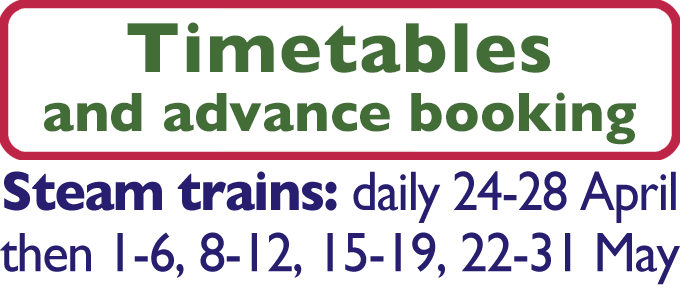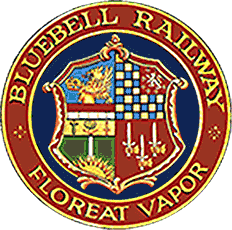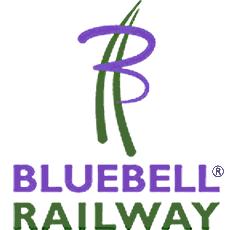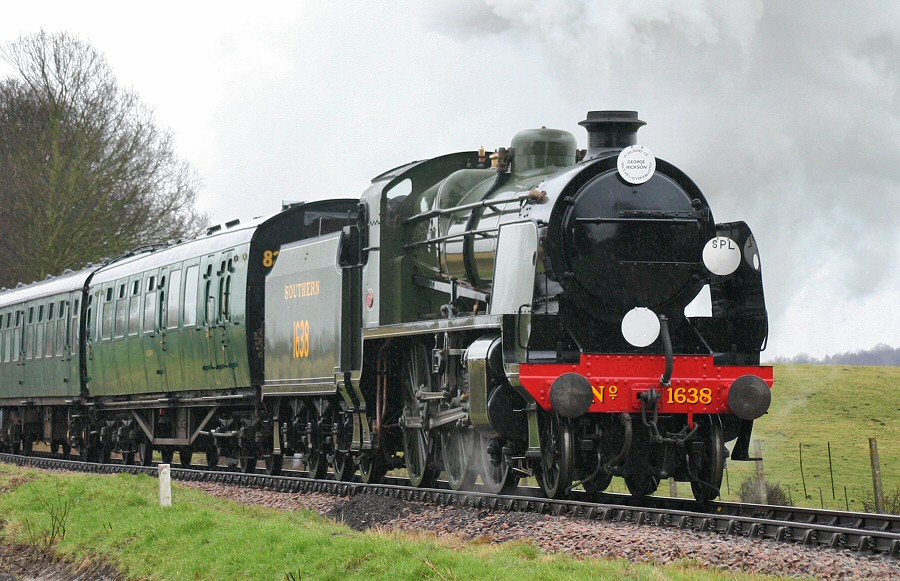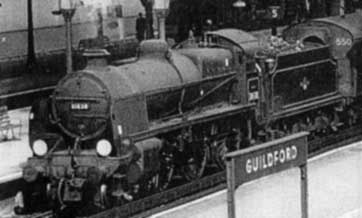Richard Maunsell had prototyped his N-class 2-6-0 (with 5' 6" driving wheels, intended for goods traffic) and K-class 2-6-4 Tank locomotives (with 6' diameter driving wheels, intended for passenger work) during his time as Chief Mechanical Engineer (CME) of the SE&CR (South Eastern & Chatham Railway). They were thoroughly modern locomotives for their time, with tapered boilers which steamed well, and performed very efficiently. Under a 1917 Government plan they were destined to become a standard locomotive to be used across the entire country, although the suggestion that the railways might be nationalised was not seen through at that time, and in 1923 instead the "Big Four" companies came into being at the Grouping. The SE&CR joined with the Brighton and South Western companies to form the new Southern Railway, Maunsell was to be the overall CME, and these designs (along with 3-cylinder variants) were set to become the first standard Southern designs.
Taking a step back, towards the end of 1919 the Ministry of Munitions sought railway work to avoid unemployment as armaments manufacturing was scaled back following the end of the First World War. A somewhat chaotic plan saw an order placed with Woolwich Arsenal to construct 50 N-class locomotives. However, the SE&CR decided they did not want them, and Woolwich did not build the boilers (110 instead being built by three railway locomotive contractors). Eventually 100 of the kits of parts constructed were sold, two batches to railway in Ireland (some completed with 6' diameter wheels) and 6 sold to the Metropolitan railway, in addition to 50 sold to the Southern Railway as N-class locomotives, and the SR also bought spare boilers and other components left over at the end of the process, used to create 3-cylinder N1s, and Ks and Us.
The K-class tanks were good engines, and in SR days were named after rivers, a batch of 10 being built at Ashford, including one (class K1) with three cylinders, and another batch of them ordered from Brighton Works in 1925 (with authorisation also for a further 20). But they were hampered by a lack of range for non-stop running (due to just carrying 2,000 gallons of water in their tanks) and more seriously by bad riding. The latter issue came to a head in the Sevenoaks disaster in August 1927 when No. A800 'River Cray' derailed, and with 13 people killed and 43 injured, there was much adverse publicity about "The Rolling Rivers". The entire class (including the sole K1 No. A890, which had itself derailed twice) were taken out of service. After extensive trials, both on the western section of the Southern, and the LNER, it was concluded that the tank raised the centre of gravity too much, and when running over poorly ballasted track, oscillations could build up as the water in the tanks moved to and fro. This resulted in the decision to rebuild all the tank locomotives as U-class 2-6-0s, with tenders.
So the story of the origins of the U-class is a complex one, with some built (at both Ashford and Brighton) as tank locomotives, converted to tender engines, some ordered and part constructed before the change to tender locomotives was made, some parts coming from Woolwich, and finally 20 U1-class (with three cylinders) being built at Eastleigh. Those U-class locomotives built as such could be distinguished from the ones rebuilt from tanks by their higher running plates, and consequently smaller splashers.
The rebuilds and the first 20 built as Us received straight-sided 3,500 gallon tenders. The final batch (including 1638) received 4,000 gallon tenders with a turned-in top section. In addition, 20 original 3,500 gallon tenders were swapped for new 4,000 gallon ones when the Q-class was built in 1938-9, with the new 0-6-0 locomotives taking the old (smaller) tenders. These larger tenders went to Nos. 1610-1629. Photos however show 31638 with a smaller tender in 1952 and 1958.
A further variation within the class came in the late 1950s when some locomotives required new frames, and also received new cylinders with outside steam pipes. That this work was considered worth doing is a testament to a design which was by that time essentially 40 years old. Also in the 1950s some locomotives received BR Standard 4 blast pipes and chimneys.
No. A638 was one ordered and built as a U-class, at Ashford in 1931, with a 4,000-gallon tender. Initially allocated to Redhill, it moved in 1933 to Guildford when re-numbered 1638, working usually to Redhill and Tonbridge. Following an overhaul in 1936, it moved to Bournemouth shed, but was reallocated to Reading in 1937 where it stayed for six years, going on to Exmouth Junction in 1943. In 1946 it was stored out of use at Eastleigh for a year, then returning to Exmouth Junction. In 1949, as No. 31638, it moved to Stewarts Lane shed, following which it led an unusually nomadic existence, allocated in turn to Faversham, Hither Green, Redhill, Brighton, Eastleigh, Redhill (again), Hither Green and Fratton. It stayed here from 1953 until the shed closed in 1959, when it moved finally to Guildford where it stayed until withdrawn from service in 1964.
1638 is one of two U-class locomotives on the Bluebell Railway, both coming via Barry Scrapyard. It has been placed on long-term loan to the Maunsell Locomotive Society, which also owns 1618, and was their main restoration project for over a decade. Having lost its tender whilst at Barry, a new one has been built - starting from the remains of a snowplough which in turn had been created using a Schools class locomotive tender as its base. The loco steamed for the first time in preservation in February 2006.
David Harp's photo above shows the U on the 19th February 2006, at the head of the lunch-time Golden Arrow Pullman train. The second photo above (from Andrew Strongitharm) shows the loco at Sheffield Park the previous day.
The photo on the right (courtesy of the Maunsell Locomotive Society) shows No. 1638 at Guildford in BR days (as No. 31638).
The Maunsell Society won three awards for the restoration of 1638, including the prestigious Heritage Railway Association's John Coiley Award for Locomotive Projects. The citation reads "For restoring and maintaining their fleet of Maunsell Locomotives, as exemplified by the restoration of 'U' Class 2-6-0 No.1638 from scrapyard condition".
No. 1638 was a popular and reliable performer after entering Bluebell service at the start of 2006. However towards the end of 2008 it was noticed that water was leaking from some boiler stays and the loco entered the works for attention that November. The boiler was lifted up clear of the frames and 148 stays - mostly below footplate level, and all of the ones that had not been replaced during the course of restoration - were replaced. The engine returned to traffic again in February 2009, running until 2015.
The locomotive is therefore now stored, on public display, awaiting an overhaul. It requires boiler work, including attention to the firebox, and new driving wheel tyres.
Class: U
Wheels: 2-6-0
Class Introduced: as K-class tank engines in 1917, as U-class 1928
Designer: Richard Maunsell
Built: 9 May 1931 at Ashford Works
Purpose: Mixed traffic, but more focussed on passenger services
Total number built: 50 (including 20 rebuilt from Rivers)
Numbers carried: A638, 1638 (from 26 May 1933), 31638
Withdrawn from BR service: 5 January 1964
Arrived on Bluebell Railway: 1 August 1980
Length: 57ft 6in overall
Weight - Locomotive: 62 Tons 6 cwt
Tender: T734, built 1935, converted to Snowplough ADS 70228 December 1964, withdrawn 4 July 1996.
Weight - Tender: 42 Tons 8 cwt
Water capacity: 4,000 Gallons
Coal capacity: 5 Tons
Boiler Pressure: 200 lb/sq.in
Driving Wheels: 6ft diameter
Cylinders: (2, outside) 19" x 28"
Tractive Effort: 23,865 lbs
Engine brake: Steam
BR power classification: 4P3F
Current status: On display, awaiting overhaul
Service on the Bluebell: 18 February 2006 - July 2015
Owner: Bluebell Railway, on long-term loan to the Maunsell Locomotive Society - MLS web page for 1638
